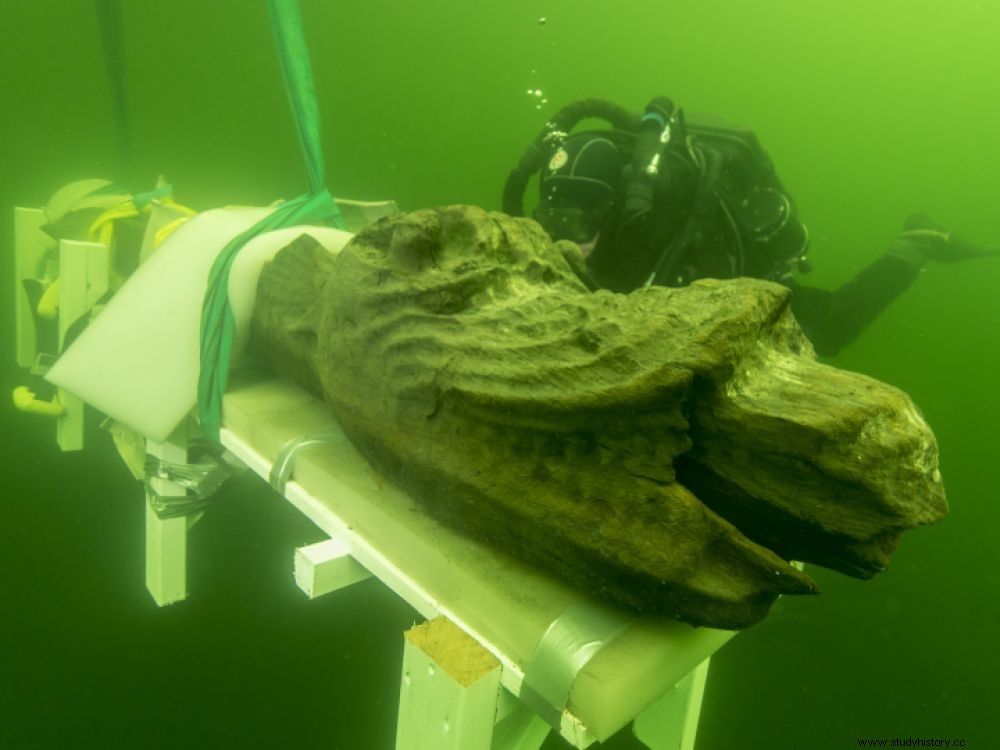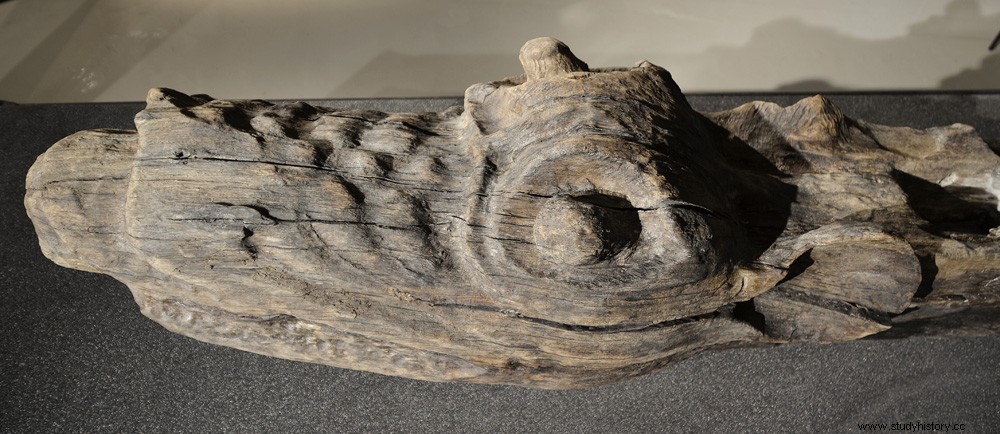With the Gribshunden , the first caravel in Northern Europe, King Hans I st of Denmark displayed vast naval ambitions. But in 1495, an explosion destroyed his flagship off Sweden. The course of history was probably changed, even if the fascination exerted by this unique building continues to be exercised by archaeologists who bring back the remains buried in the Baltic Sea.

The figurehead of the Gribshunden , rising to the surface from the bottom of the Baltic Sea.
In the summer of 1495, King Hans I of Denmark (1455-1513) sailed for Sweden at the head of a fleet of 18 ships. His destination:the city of Kalmar, where he is to meet the regent Sten Sture, who challenges his overlord power. However, according to the Treaty of Kalmar signed in 1397, the Danish monarch also rules over Sweden and Norway, determining their common foreign policy, even if each country retains its internal autonomy. The Norwegians resigned themselves, but the Swedish nobility resisted. Hans therefore comes to meet them with the intention of restoring the union and restoring his power; to impress them, he relies on the splendor of his flagship, the Gribshunden .
The Gribshunden has been buried in the Baltic Sea for over 500 years
In the 1970s, divers from a local sports club discovered in Ronneby Bay, southern Sweden, a pile of pieces of wood lying 10 meters deep. Nothing really notable, they think, refraining from notifying the archaeological services. And yet, at this exact spot in the Baltic Sea, north of the island of Stora Ekön in the Blekinge archipelago, there is only one ship that has failed in history, it is the Gribshunden (literally "dog-griffin"), the flagship of King Hans I of Denmark. The first archaeological research will only take place in the 2000s, and the definitive identification of the wreck, largely buried in the sediments, will be made in 2013 thanks to dendrochronology. Tracking investigations follow in 2015, then limited excavations in 2019 allow conclusive artefacts to be brought to the surface – including the figurehead of the ship –, before researchers from the University of Lund (Sweden) can carry out in May 2021 the first real excavation campaign.

Found in 2015, the oak wood figurehead represents a monster, probably a dragon-headed griffin (chimerical being), devouring a man. She weighs 250 kg . © Morgan Olsson / Blekinge museum
An avant-garde construction
As its manufacture proves, the Gribshunden was a prestigious ship, archaeologists point out. Dendrochronological analyzes indeed indicate that the wood of the wreck comes from oak trees felled during the winter of 1482-1483, which grew on the banks of the Meuse, in Holland, suggesting that the Danish monarch acquired the boat in the foreign. This hypothesis is corroborated by the construction technique of the ship, which combines hull construction, where the planks of the hull are placed edge to edge, and the clapboard method, where the planks overlap, typical of Northern Europe. . It is this type of hybrid construction, practiced by Spanish and Portuguese carpenters, which allowed the Iberian caravels to cross the oceans; larger boats are thus built, able to stay for months at sea, and able to carry a vast cargo as well as heavy guns. At 32 meters long, the Gribshunden is therefore a precursor building for northern Europe. Because Hans harbored great naval ambitions, which he could not realize because of Swedish opposition. On board his avant-garde ship, he probably traveled to Greenland, believes Brendan Foley, the underwater archaeologist leading the current research. And he might have succeeded in building an empire if the Gribshunden had not burned off Stora Ekön in 1495.
The ship is burning!
In the summer of 1495, King Hans I st of Denmark (1455-1513) sailed for Sweden at the head of a fleet of 18 ships. His destination:the city of Kalmar, where he is to meet the regent Sten Sture, who challenges his overlord power. However, according to the Treaty of Kalmar signed in 1397, the Danish monarch also rules over Sweden and Norway, determining their common foreign policy, even if each country retains its internal autonomy. The Norwegians resigned themselves, but the Swedish nobility resisted. Hans therefore comes to meet them with the intention of restoring the union and restoring his power; to impress them, he relies on the splendor of his flagship, the Gribshunden .
The Gribshunden has been buried in the Baltic Sea for over 500 years
In the 1970s, divers from a local sports club discovered in Ronneby Bay, southern Sweden, a pile of pieces of wood lying 10 meters deep. Nothing really notable, they think, refraining from notifying the archaeological services. And yet, at this exact spot in the Baltic Sea, north of the island of Stora Ekön in the Blekinge archipelago, there is only one ship that has failed in history, it is the Gribshunden (literally "dog-griffin"), the flagship of King Hans I st from Denmark. The first archaeological research will only take place in the 2000s, and the definitive identification of the wreck, largely buried in the sediments, will be made in 2013 thanks to dendrochronology. Tracking investigations follow in 2015, then limited excavations in 2019 allow conclusive artefacts to be brought to the surface – including the figurehead of the ship –, before researchers from the University of Lund (Sweden) can carry out in May 2021 the first real excavation campaign.

Found in 2015, the oak wood figurehead represents a monster, probably a dragon-headed griffin (chimerical being), devouring a man. She weighs 250 kg . © Morgan Olsson / Blekinge museum
An avant-garde construction
As its manufacture proves, the Gribshunden was a prestigious ship, archaeologists point out. Dendrochronological analyzes indeed indicate that the wood of the wreck comes from oak trees felled during the winter of 1482-1483, which grew on the banks of the Meuse, in Holland, suggesting that the Danish monarch acquired the boat in the foreign. This hypothesis is corroborated by the construction technique of the ship, which combines hull construction, where the planks of the hull are placed edge to edge, and the clapboard method, where the planks overlap, typical of Northern Europe. . It is this type of hybrid construction, practiced by Spanish and Portuguese carpenters, which allowed the Iberian caravels to cross the oceans; larger boats are thus built, able to stay for months at sea, and able to carry a vast cargo as well as heavy guns. At 32 meters long, the Gribshunden is therefore a precursor building for northern Europe. Because Hans harbored great naval ambitions, which he could not realize because of Swedish opposition. On board his avant-garde ship, he probably traveled to Greenland, believes Brendan Foley, the underwater archaeologist leading the current research. And he might have succeeded in building an empire if the Gribshunden had not burned off Stora Ekön in 1495.

This is what the Gribshunden must have looked like. © Mats Vänehem / Blekinge museum
The ship is burning!
Sources mention an explosion and fire aboard the ship, but archaeologists have yet to find any trace of it. It would be the gunpowder stash that accidentally ignited, as the Gribshunden was also a military ship of a particular kind, both equipped for medieval naval battles – which consisted in seizing the enemy boat by eliminating the crew –, and for naval warfare as it will be practiced from of the 16 th century, which involves ranged combat and the destruction of enemy buildings. He thus arranged at the stern and bow of brick castles, similar to the turrets of a fortress, to practice hand-to-hand combat after the boarding; but it also housed several dozen cannons, which was a novelty for the time. The researchers indeed brought to the surface more than a dozen wooden swivel gun carriages, but the guns themselves disappeared, this phenomenon constituting a new specificity of the wreck.

Oak wooden gun carriage. © Morgan Olsson / Blekingemuseum
The wood has been exceptionally preserved by the very low salt water of the Baltic
In the very low salt water of the Baltic Sea, the wood has been protected from destruction, because the shipworms (vermiform molluscs) which usually devour it cannot live there. Most of the elements of the ship and the objects found were therefore made of wood:planks, barrels, crossbows, arrows, capstan, plates, tankards... On the other hand, the iron objects, and especially the cannons, were decomposed by anaerobic bacteria. The other metals survived, such as a pile of coins which could correspond to the pay of the lansquenets, or hundreds of copper rings, which could come from a coat made by a famous armorer of Nuremberg, a sign that soldiers Germans were on board. It is also from Germany that the lead comes from cannonballs, which were able to resist under water because of their toxicity. Their size, about the size of a tennis ball, confirms that the guns of the Gribshunden were not made to sink the enemy, but to kill men.

Lead cannonball. The crack indicates that the core was probably iron. © Morgan Olsson / Blekingemuseum
Only 1% of the Gribshunden has so far been updated
When the ship explodes, King Hans is not on board; he is said to have disembarked shortly before on his way to a meeting with Danish and Norwegian nobles. But some 150 people are there:the crew, the soldiers and a large part of the court; this is why archaeologists expect to find human bones during the next excavations which will take place from the summer of 2022. There is still so much to discover, reveals Brendan Foley, since so far only 1% of the riches from Gribshunden was discovered. As the birch bark panels, delicately adorned with floral and animal motifs, suggest, it would seem that the ship was elaborately decorated, for in order to impress the Swedish nobles, Hans had spared no means. The kitchen also gives an idea of the luxury that reigned on board:peppercorns, cloves and saffron found in a spice rack show that the king appreciated exotic foods, and, in a barrel, the remains of a sturgeon almost 2 meters long also attest to the feasts that took place on board.
What was shipped in 1495 is still there
As Stockholm University archaeologist Niklas Eriksson explains in a statement from the Blekinge Museum in Karlskrona where the found objects are kept, the Gribshunden represents a unique opportunity, that of being able to examine the entirety of a ship from the end of the Middle Ages, to analyze its revolutionary technology as well as life on board. "Research shows that what was loaded on the Gribshunden in 1495 is largely still there ", he marvels. The only example of a caravel still intact, the Gribshunden fascinates more than ever... even though in 1495, he was unable to play the role assigned to him:his disappearance not only diminished the prestige of King Hans, but delayed negotiations with Sweden and the restoration of Danish power, albeit precarious, over its Scandinavian neighbours.
